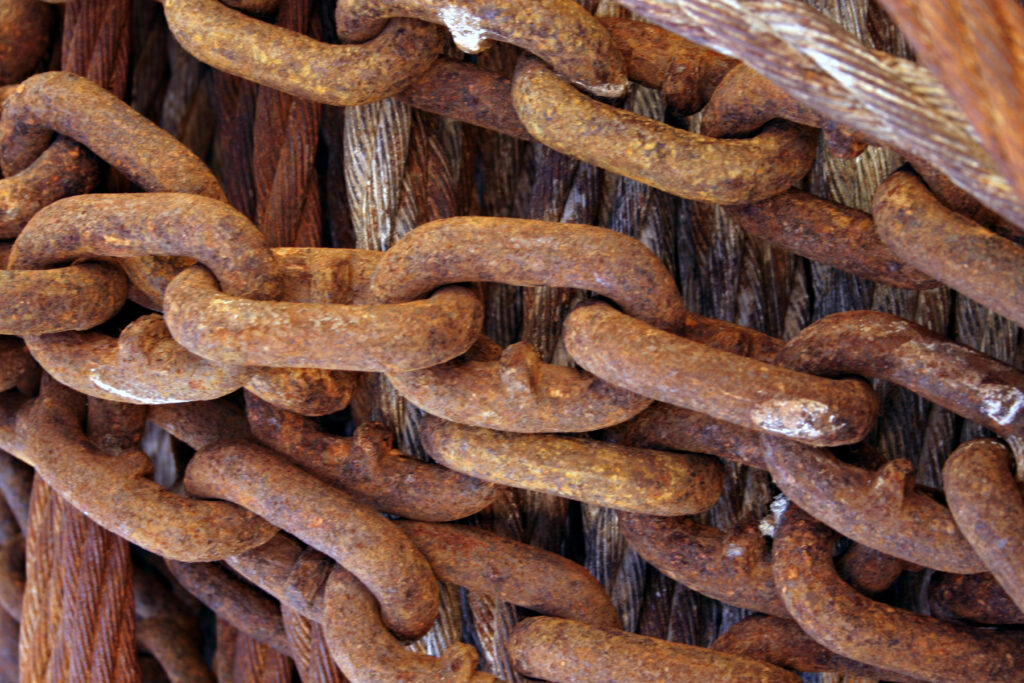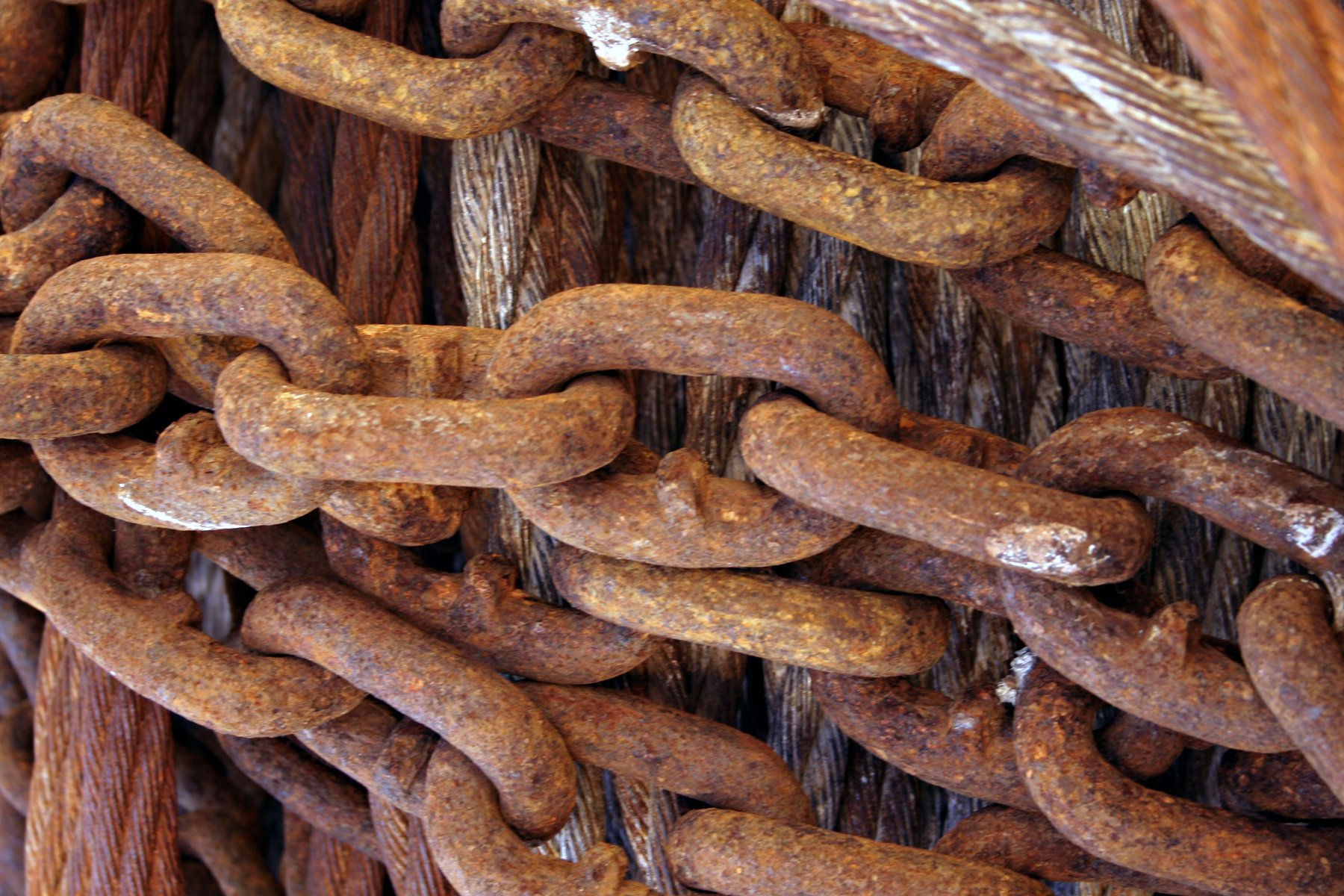
The Silent Killer: Understanding and Combating Rusted Chains
A rusted chain, often overlooked, can be a silent killer in various applications, from industrial machinery to everyday bicycles. Its presence signifies degradation, potential failure, and significant safety risks. This article delves into the causes, consequences, and effective strategies for preventing and combating rusted chains, providing a comprehensive understanding for professionals and enthusiasts alike.
The Anatomy of Rust: A Chemical Perspective
Rust, scientifically known as iron oxide, is the result of an electrochemical reaction between iron, oxygen, and moisture. When these elements interact, iron atoms lose electrons and become ions, forming a reddish-brown layer that we recognize as rust. This process, known as oxidation, weakens the metal structure and compromises its integrity. Understanding this basic chemistry is crucial for devising effective prevention methods.
Factors Accelerating Rust Formation
- Humidity: High humidity levels provide ample moisture, accelerating the oxidation process.
- Saltwater Exposure: Saltwater is a potent catalyst for rust, as the chloride ions accelerate the electrochemical reaction. Coastal environments and marine applications are particularly vulnerable.
- Acidic Environments: Exposure to acidic substances, such as acid rain or industrial pollutants, can corrode the protective layers on the metal surface, making it more susceptible to rust.
- Lack of Maintenance: Neglecting regular cleaning and lubrication allows moisture and contaminants to accumulate, promoting rust formation.
The Consequences of a Rusted Chain
The implications of a rusted chain extend far beyond aesthetics. A compromised chain can lead to:
- Reduced Strength: Rust weakens the metal, reducing the chain’s load-bearing capacity. This can lead to catastrophic failures in critical applications.
- Increased Friction: Rust increases friction between the chain links, leading to reduced efficiency, increased wear and tear, and potential overheating.
- Stiff Movement: Rust can seize the chain links, making it difficult or impossible to move smoothly. This can cause operational disruptions and require costly repairs.
- Safety Hazards: In applications such as lifting equipment or bicycle chains, a rusted chain can pose a significant safety risk, potentially causing accidents and injuries.
Prevention is Better Than Cure: Proactive Strategies
Preventing rust is far more cost-effective and safer than dealing with its consequences. Here are some essential preventative measures:
Protective Coatings
Applying protective coatings is a primary defense against rust. Common options include:
- Galvanization: Coating the chain with a layer of zinc provides a barrier against corrosion. Zinc corrodes preferentially, protecting the underlying steel.
- Powder Coating: Applying a durable powder coating creates a protective layer that is resistant to scratches, chemicals, and UV radiation.
- Specialized Rust-Inhibiting Paints: These paints contain chemicals that inhibit the oxidation process, providing an additional layer of protection.
Regular Cleaning and Lubrication
Regular cleaning removes dirt, grime, and contaminants that can promote rust formation. Lubrication reduces friction and prevents moisture from reaching the metal surface. Consider these steps:
- Cleaning: Use a wire brush or solvent to remove loose rust and debris.
- Drying: Ensure the chain is completely dry before applying lubricant.
- Lubrication: Apply a high-quality lubricant specifically designed for chains. Ensure the lubricant penetrates all the links.
- Wiping: Wipe off excess lubricant to prevent dirt and grime from accumulating.
Material Selection
Choosing the right material for the application is crucial. Stainless steel chains offer excellent corrosion resistance but can be more expensive. Consider the environmental conditions and the required strength when selecting the chain material.
Proper Storage
When chains are not in use, store them in a dry, well-ventilated area. Avoid storing chains directly on the ground or in damp locations. Consider using a desiccant to absorb moisture in the storage area.
Combating Existing Rust: Remedial Actions
If a rusted chain is already present, prompt action is necessary to mitigate further damage and restore its functionality. Here are some common methods for removing rust:
Mechanical Removal
Mechanical removal involves physically removing the rust using tools such as:
- Wire Brushes: Effective for removing loose rust and debris.
- Sandpaper: Use different grits of sandpaper to gradually remove rust without damaging the underlying metal.
- Grinders: For heavy rust, a grinder with a wire wheel can be used, but caution is advised to avoid removing too much material.
Chemical Removal
Chemical rust removers contain acids or chelating agents that dissolve rust. Follow the manufacturer’s instructions carefully and wear appropriate safety gear, such as gloves and eye protection. Common chemical rust removers include:
- Phosphoric Acid: Converts rust into a protective phosphate coating.
- Oxalic Acid: Dissolves rust and can brighten the metal surface.
- Vinegar: A mild acid that can be effective for removing light rust.
- Citric Acid: Another mild acid that is environmentally friendly and effective for removing rust.
Electrolytic Rust Removal
Electrolytic rust removal uses an electric current to remove rust. This method is more complex but can be very effective for heavily rusted chains. It involves submerging the chain in an electrolyte solution and connecting it to a DC power source.
Case Studies: Real-World Examples
To illustrate the importance of rust prevention and remediation, consider these case studies:
Industrial Application: Crane Chains
A construction company neglected to maintain the chains on their cranes, leading to significant rust formation. The rusted chain eventually failed during a lifting operation, causing a serious accident and significant property damage. This incident highlighted the critical importance of regular inspection and maintenance of crane chains.
Marine Application: Boat Anchor Chains
A boat owner discovered severe rust on their anchor chain after a season of use in saltwater. The rusted chain had lost significant strength and was at risk of breaking during rough seas. The owner replaced the chain and implemented a regular cleaning and lubrication schedule to prevent future rust.
Bicycle Application: Derailleur Chains
A cyclist experienced frequent chain slippage and poor shifting performance due to a rusted chain. The rust increased friction and prevented the chain from engaging properly with the gears. After cleaning and lubricating the chain, the cyclist restored smooth and reliable shifting performance.
The Future of Rust Prevention: Innovations and Technologies
Ongoing research and development are leading to innovative solutions for rust prevention. These include:
- Self-Healing Coatings: Coatings that can automatically repair minor scratches and damage, preventing rust from forming.
- Nanotechnology: Using nanoparticles to create ultra-thin, highly effective protective layers.
- Improved Lubricants: Lubricants that offer superior corrosion protection and longer-lasting performance.
Conclusion: Protecting Your Assets
A rusted chain is a serious issue that can have significant consequences. By understanding the causes of rust, implementing preventative measures, and taking prompt action to address existing rust, you can protect your assets, ensure safety, and maintain operational efficiency. Whether you are managing industrial equipment, maintaining a boat, or simply riding a bicycle, taking care of your chains is an investment in long-term reliability and safety. Ignoring a rusted chain can lead to costly repairs, accidents, and even loss of life. Prioritize rust prevention and remediation to ensure the longevity and performance of your chains. Don’t let a rusted chain become a silent killer. [See also: Chain Maintenance Best Practices] [See also: Types of Chain Lubricants] [See also: Identifying Chain Wear and Tear]

